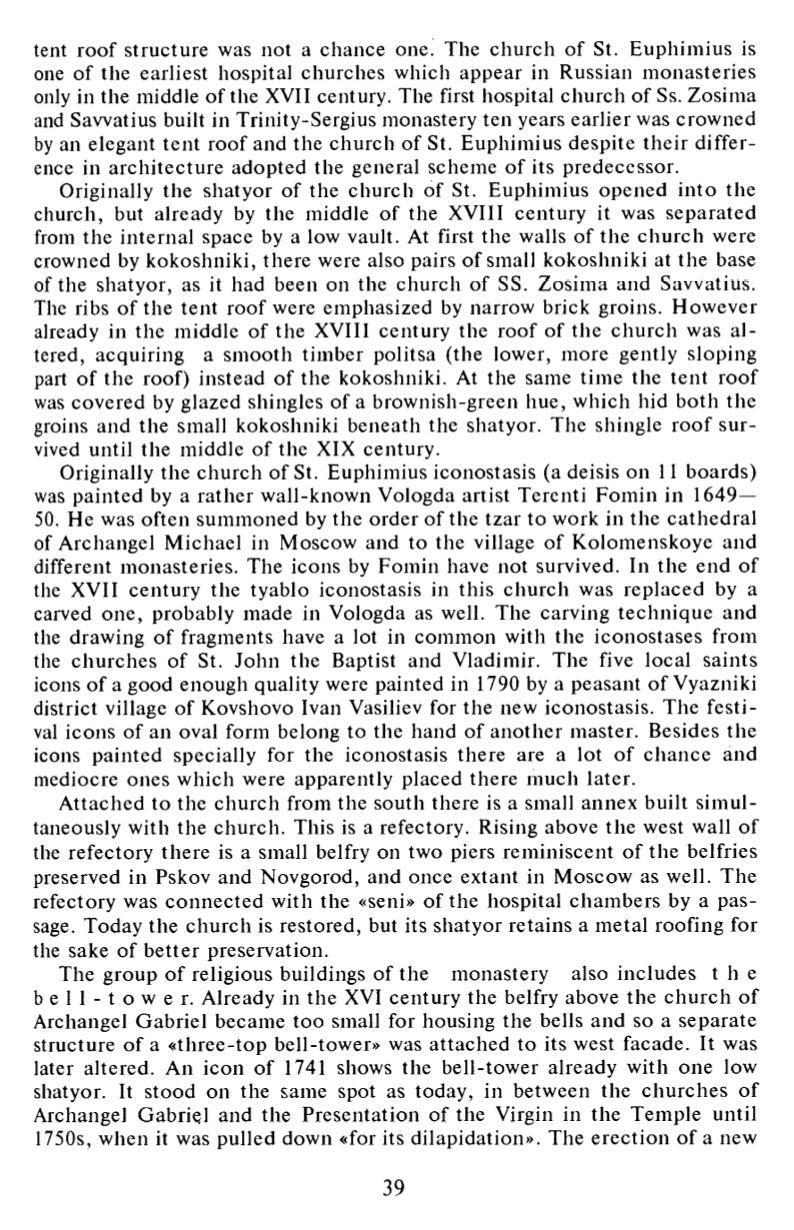

tent roof structure was not a chance one. The church of St. Euphimius is
one of the earliest hospital churches which appear in Russian monasteries
only in the middle of the XVII century. The first hospital church of Ss. Zosima
and Sawatius built in Trinity-Sergius monastery ten years earlier was crowned
by an elegant ten t roof and the church of St. Euphimius despite their differ
ence in arch itecture adopted the general scheme o f its predecessor.
Originally the shatyor of the church of St. Euphimius opened in to the
church, but already by the middle o f the XVIII century it was separated
from the internal space by a low vault. At first the walls of the chu rch were
crowned by kokoshniki, there were also pairs of small kokoshniki at the base
of the shatyor, as it had been on the church of SS. Zosima and Sawa tius.
The ribs o f the ten t roof were emphasized by narrow brick groins. However
already in the middle of the XVIII century the roof of the chu rch was a l
tered, acquiring a smooth timber politsa (the lower, more gently sloping
part o f the roof) instead o f the kokoshniki. At the same time the ten t roof
was covered by glazed shingles of a brownish-green hue, which hid bo th the
groins and the small kokoshniki beneath the shatyor. The shingle roo f su r
vived until the middle of the XIX century.
Originally the church of St. Euphimius iconostasis (a deisis on 11 boards)
was painted by a rather wall-known Vologda artist Terenti Fomin in 1649—
50. He was often summoned by the order o f the tzar to work in the cathedral
of Archangel Michael in Moscow and to the village of Kolomenskoye and
different monasteries. The icons by Fomin have not survived. In the end of
the XVII century the tyablo iconostasis in this chu rch was replaced by a
carved one, probably made in Vologda as well. The carving techn ique and
the drawing o f fragments have a lot in common with the iconostases from
the churches of St. John the Baptist and Vladimir. The five local saints
icons o f a good enough quality were painted in 1790 by a peasant o f Vyazniki
district village of Kovshovo Ivan Vasiliev for the new iconostasis. The festi
val icons of an oval form belong to the hand of ano ther master. Besides the
icons painted specially for the iconostasis there are a lot o f chance and
mediocre ones which were apparently placed there much later.
Attached to the church from the south there is a small annex built simu l
taneously with the church. This is a refectory. Rising above the west wall o f
the refectory there is a small belfry on two piers reminiscent o f the belfries
preserved in Pskov and Novgorod, and once extant in Moscow as well. The
refectory was connected with the «seni» of the hospital chambers by a pas
sage. Today the chu rch is restored, but its shatyor retains a metal roofing for
the sake of be tte r preservation.
The group o f religious buildings of the monastery also includes t h e
b e l l - t o w e r . Already in the XVI century the belfry above the chu rch o f
Archangel Gabriel became too small for housing the bells and so a separate
structure o f a « three-top bell-tower» was attached to its west facade. It was
later altered. An icon o f 1741 shows the bell-tower already with one low
shatyor. It stood on the same spot as today, in between the chu rches o f
Archangel Gabriel and the Presentation of the Virgin in the Temple until
1750s, when it was pulled down «for its dilapidation». The e rection o f a new
39















